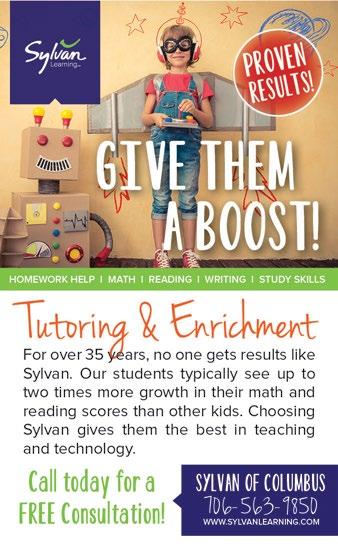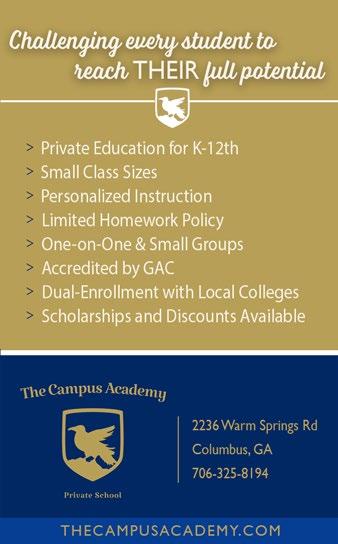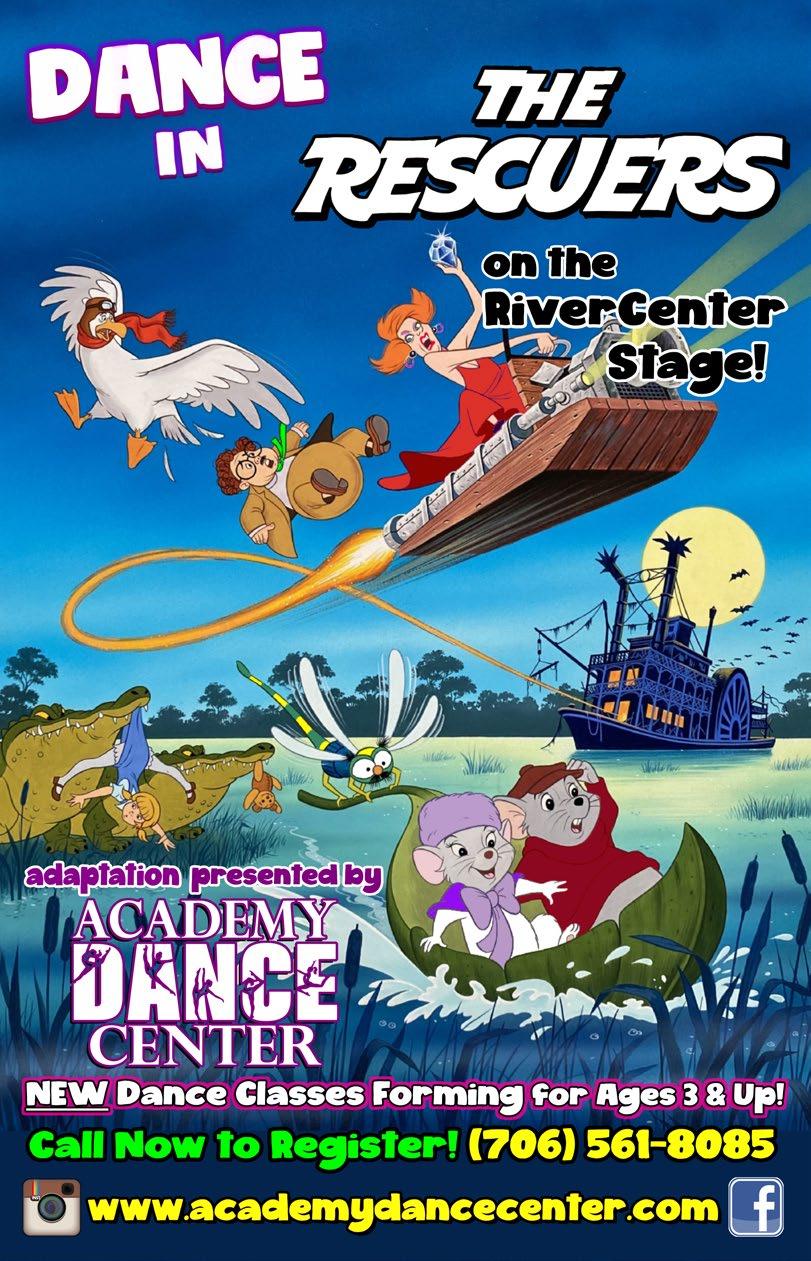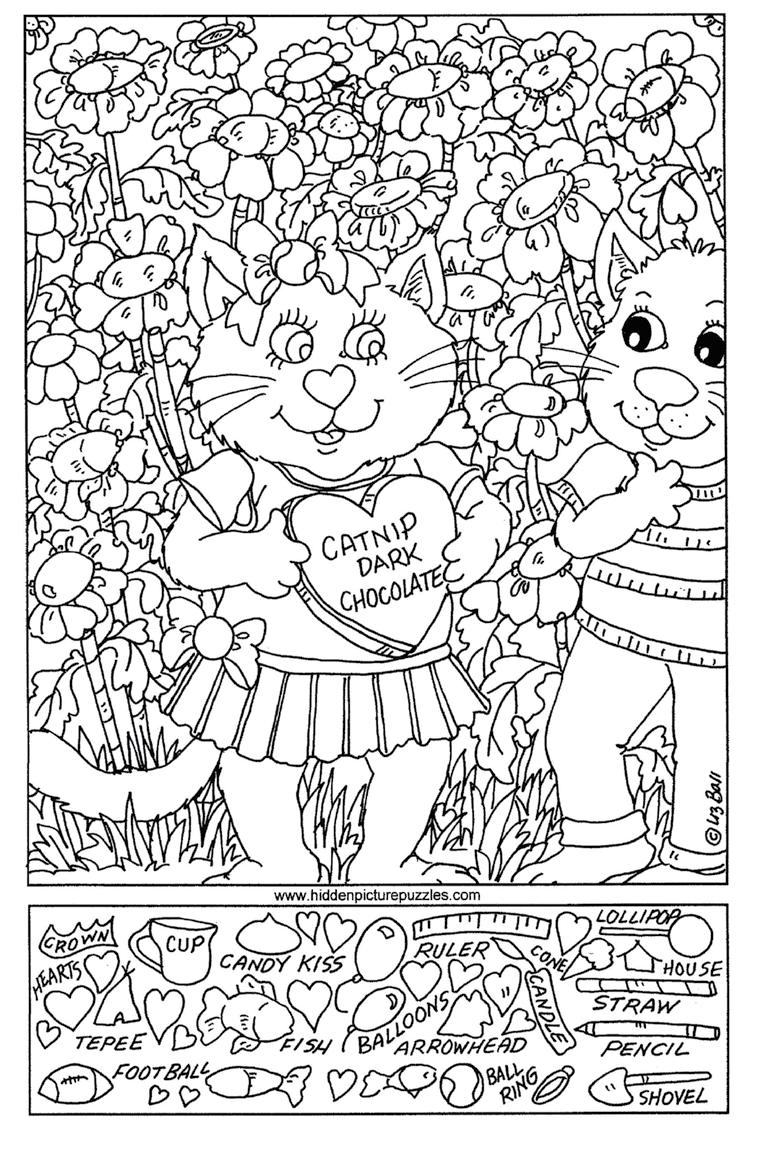CHATTAHOOCHEE VALLEY

When every minute counts, we’re here with high-quality emergency care. See Back Cover for Sponsor Ad





When every minute counts, we’re here with high-quality emergency care. See Back Cover for Sponsor Ad



Did you know that your child’s birth order may influence their personality? There are characteristic traits of the oldest child, middle child, youngest child and the only child that make them one-of-a-kind when it comes to personality. As a parent, recognizing these unique differences can benefit your relationship with your child and their relationship with their siblings.


The Scientific America article, “Does Birth Order Affect Personality” shares that often firstborn children are leaders who commonly choose influential careers and often have a small IQ advantage compared to their siblings. The article suggests that the individual attention firstborns receive early in life may be beneficial to their cognitive abilities throughout life. Characteristically, firstborn children are known to be mature, goal-oriented, independent and confident. As families grow, the firstborn child takes on roles related to parenting as they become little helpers around the house. They often become competitive, a trait that an only child often doesn’t share. Make firstborn children feel valued by spending individual time with them each week and recognize all the little things they do to help with younger siblings.
Parents to firstborn children are new to the job; they create rules as situations arise and document all the ‘firsts’ with unlimited pictures and video recordings. But, as families grow, sharing learning experiences individually with each child becomes increasingly
more of a challenge. By the second child, parents tend to be more easygoing with their parenting responsibilities. As a result, middle children tend to be more creative, social and fun. They have never experienced being an only child, but as the youngest child, they get quite a bit of attention and are great negotiators in many families. However, when they become the middle child, it is often a major adjustment. As a result, they may feel left out of the family dynamics and gravitate towards their friendships. Giving them a role in the family is important and will help them build relationships with their siblings. As a parent, spend time with them individually and give them opportunities to feel special.
Usually, by the final child, parents are experienced and have an even more relaxed parenting style. As a result, the youngest child often has a free-spirited and funny personality. The baby of the family is often spoiled by parents as this is their final child. However, first accomplishments of the youngest often go unnoticed. It is important for parents to document moments for that last child with pictures and videos too. As a parent, it is important to give the last child confidence to reach their goals and encourage them to be independent throughout their life.
Over the years, as your family grows, the birth order dynamics will change. As a parent, it is important to be adaptable and teach your children to use their unique personality traits as a gift. This ‘gift’ can be used to encourage their siblings, make new friends and positively influence those around them. While reading together, have older siblings read out loud, encourage middle children to follow along with their finger and younger siblings to snuggle close and listen. Remember, it is the time that you spend together as a family that will impact your kids the most because they will know that they are loved, which is the greatest ‘gift’ you can give them.






Did you know that February 9th is National Pizza Day? Pizza is one of America’s favorite foods. Most Americans order pizza at least once a month!
Did you know that pizza got its start as an affordable meal for families in Italy? Soldiers stationed in Italy likely were influential in making pizza an American sensation upon their return home from World War II.
It first came to the states in 1897, known as an ‘Italian pie.’ The first ‘pies’ were sold in grocery stores in New York. The owner, Gennaro Lombardi opened the first pizzeria in 1905!
According to a 2022 survey of over 2,000 adults by OnePoll, Americans’ least-favorite pizza toppings, in order, are anchovies, pineapple and jalapeno peppers. A majority of respondents said that they’d be willing to try plant-based meat toppings, if the alternative “tasted just as good” as the original.
There were variations in how the respondents preferred to eat their slices. Slightly over a quarter go pointy-end first, less than 20 percent attack it from the crust side, another 17 percent fold it in half, and an eager 14 percent say they stack two slices and eat them simultaneously.


The role of a stepparent comes with some unique challenges. You are forming a new family and attempting to blend two sets of traditions and household rules. The stepchildren may feel upset about their parent’s divorce and remarriage, and you may become the target of their frustration. Here are a few points to consider during the transition.
By Linda Ligon, Family & KidsDo not set your initial expectations too high. It will take time to build a bond with your new stepchildren. Your job as a stepparent is to be available to them as a mentor and guide. You are not a replacement for their parent. At first, leave all the discipline up to their parents, making yourself available when needed to support the decisions your spouse or their ex makes about their discipline. One mistake new stepparents sometimes make is to try too hard. Do not try to ‘win’ your stepchildren over by buying them extravagant gifts or trying to be their best friend. Instead, let your stepchildren know you are available if they need someone to talk to and give them some space as they adjust to their new family situation. They will start coming to you for your support when they are ready. Attempting to force them to interact with you may only increase the feelings of resentment your stepchildren may be having.
While it is not your place to be the primary disciplinarian of your stepchildren, you and your spouse need to come together and agree on a set of household rules that apply to everyone in the family. Have family meetings to discuss household rules and to define your expectations for all children in the household. Ensure you apply the same rules and expectations to both your biological children and your stepchildren. Inconsistency in setting boundaries and rules will be divisive and cause conflict. Avoid the tendency to play favorites and make exceptions for your biological children. Remember that the new household rules may be a change for your stepchildren from their previous environment and give them the opportunity to voice their feelings about the new expectations being set for them.
Have your spouse give you some insight into what activities your stepchildren enjoy. Then show interest in your stepchildren’s hobbies and activities. For example, if your stepchild enjoys crafting, pick out a project that you could work on together. Also spend time with your stepchild on every day, routine tasks such as completing homework and fixing dinner. Help your all the members of your new blended family become familiar with each other by planning an outing to a state park, museum or amusement park that everyone in the family can enjoy.
A strong marriage is the foundation for your new family. Having a strong marriage helps your family to thrive. Do not let your biological children attempt to put you in a position where they try to force you to choose between them and your new spouse. Remind your kids that you love them just as much as before you married your new spouse. Blending a new family can be stressful, but always strive to keep your interactions with your spouse and their ex respectful. If your spouse’s parenting style is causing issues, voice your concern in a way that is not harsh and then work with your spouse to come to an agreement. Open and regular communication will keep frustration and tension from building, and help keep your home a more peaceful place for all.


Having your baby sleep in your bed with you is not a safe practice. Tragically, according to the CDC, about 3,500 infant sleep-related deaths occur each year. These deaths include those by accidental suffocation, SIDS and sleep deaths due to unknown causes. According to the American Association of Pediatrics (AAP), the risk of sleep-related death increases five to ten times when babies younger than four-months-old share a bed with a parent.
Co-sleeping is dangerous due to the fact that an infant primarily breathes through her nose and it is easy for a baby’s nose to become obstructed. Young infants do not yet have the motor skills to roll clear of an obstruction and an infant who cannot breathe through her nose may suffocate. Co-sleeping risks also include strangulation due to accidental entrapment between the mattress and headboard and the risk of the infant falling out of the bed.
The CDC and the AAP stress in published 'safe sleep' guidelines that it may be possible to prevent some sleep-related infant deaths by
By Linda Ligon, Family & Kids
creating a 'safe sleep' environment. According to the CDC and the AAP, in the first year of life, infants should sleep in a parent’s room but not in the parent’s bed. Experts warn against falling asleep with a baby on a soft chair also. Parenting a newborn can be exhausting but do not put your baby in your bed because it seems like the only way to catch up on sleep. If you need some sleep but your baby is not wanting to fall asleep in her crib, seek some help from family or friends willing to care for your baby while you get some rest.
According to the AAP, an infant should sleep on a firm mattress in her own crib or on a sleep surface that meets federal safety guidelines. Also, never use a crib that is damaged or does not come with instructions. The sleep surface should not be inclined and there should not be any blankets, pillows, crib bumpers or stuffed animals in your baby’s crib. Place your baby on her back to sleep.

In this experiment, you will determine the solubility of candy hearts in different solvents or liquids. Solubility is the amount of a substance that will dissolve in a solvent at a certain temperature. The solvents in these experiments are water, Sprite, Coca-Cola, vegetable oil and vinegar.
You may have seen a pH scale when a lifeguard tested the chemicals in a swimming pool. The pH scale measures the acidity of liquids with a scale that ranges from 0-14. On the scale, zero indicates the most acidic liquid and fourteen is the most basic. In this experiment, the most acidic liquids and the least acidic liquids differ in their ability to dissolve the candy. Let's see how.
1. Place 1 cup of various liquids into several different cups.
2. Then put a candy heart into each cup of liquid.
3. Start the timer for 20 minutes.
4. Observe what happens to each of the candy hearts and record your results.

1. Pour 1 cup of water into three cups. In cup #1, add ¼ cup sugar. In cup #2, add ¼ cup salt. Stir both until the substances are dissolved.
2. Pour 1 cup of hot water into three cups. Add ¼ cup sugar to cup #1. Add ¼ cup salt to cup #2. Stir until dissolved.
3. Add 1 candy to each cup.
4. Set your timer for 2 minutes and then record your results.
The pH and the temperature of the liquids in your experiment are sure to impact your results. Which liquids caused the candy to dissolve faster? Which liquids were slower to dissolve? What do you think caused the candy to dissolve quicker? The temperature of the water or the substance that was added?
• Candy Hearts
• Various liquids (water, Sprite, Coca-Cola, vegetable oil, vinegar)
• Glass cups or bowls
• ½ cup sugar
• ½ cup salt
• Timer
• Measuring cup





Wise Choices for You & Your Family



Sight words comprise about 60% of the words a child commonly finds in daily reading. Fluent readers effortlessly read these words, but struggling readers must stop to search for context clues or to sound out many of these words. Mastery of sight words is critical to a child’s success as a reader and scholar.
According to the Get Georgia Reading website: “Georgia has struggled for years to improve our reading proficiency rate. The cost to our state
is significant, and the cost to our children is incalculable. Our framework for action promotes third grade reading proficiency...”
The 'Sight Words Support' program at the Mildred L. Terry Public Library is a way to offer ‘language nutrition’ (in One-on-One sessions), to struggling readers, grades K- 3, by affording them additional exposure to a language-rich setting and a supportive adult.
Activities disguised as play, draw children into social and verbal exchanges that involve reading from high-frequency word lists, tracing and identifying letters, practicing sentence building and reading aloud. Fishing and matching games are used to reinforce skills that build reading fluency.
A recent exchange in a ‘Sight Words Support’ session with a 4-year-old boy revealed his joy with his session and his view of his library.
By Deborah Clark Mildred L. Terry Public LibraryAs staff and the boy celebrated his success at ‘fishing’ for, and successfully matching the word ‘at’, staff prompted his use of the word by asking, “Where are you?” To which he yelled, “AT THE BOOK HOUSE!” His mom explained that her son rejects saying ‘library.’ He prefers to visit “The Book House!”

The boy’s excitement and naming preference for his library, caused staff to resolve to keep his “BOOK HOUSE” a favorite house for him and all children - so that the ‘language nutrition’ sessions at the library will, like the nourishment at Grandma’s house, help to grow him and others into more fluent, proficient and confident readers!
Thursdays from 3-5pm
Call 706-243-2785 or email mlt@cvlga. org to make a 30-minute appointment.


For many parents, it is difficult to discuss the topic of suicide with their children. Kids may hear about a public figure or someone in the community passing away due to suicide, but some parents shy away from the topic out of fear that discussing it may cause their children to think about trying it. However, when kids are exposed to a suicide death, having an age-appropriate discussion with them about suicide may make it more likely they will have a discussion with you in the future, which could be life-saving. By bringing it up, parents are removing the stigma that surrounds the topic, they are able to dispel myths about suicide and it reaffirms to their kids that they are available to discuss it again if desired.
Be careful to keep the discussion age-appropriate. Suicide is not a topic that preschoolers will understand since preschoolers do not understand the concept of the permanence of death. Instead, you can simplify the outcome by explaining that the person was sick and therefore died, which made everyone very sad.
For elementary grade school kids, consider the developmental level of your child when discussing suicide and let your child ask questions that guide the conversation. Use short, concise answers that provide the right amount of information for your child. Explain that the person who died was sick, not in their body but in their mind, and that they probably died from a mental health disease called depression which makes someone very sad most of the time. Discuss the concept that death is permanent and the person who died is not coming back. Also, help your child start to understand his feelings and put a label, such as angry or hopeless, on them.
As kids enter the pre-teen years, the discussion of suicide can become more in-depth. Choose an appropriate time to open a discussion and begin it by asking questions to find out what your child knows about suicide. This gives you an opportunity to correct any misinformation your child has received from his peers. By this age, your child should be familiar enough with his emotions to identify if he feels sad or hopeless. Ask your child if he or his friends have ever considered suicide. Explain that if someone has a mental health condition, such as depression, that leads them to commit suicide, it is not that person’s fault but that of the illness. Have a discussion about how suicide can sometimes be prevented if depression symptoms are identified, and the person gets help in time.
By opening a discussion with your preteen about suicide, you are sending the message that you are always available to your child if he finds himself feeling hopeless and sad and needs your help. Let your child know that if a friend shows signs of depression or states he wants to harm himself, he should reach out to you or another adult. Express that he is not betraying his friend’s trust by getting him the help that could save his life.
Preteens are notorious for moody episodes but watch for those that seem out of the ordinary or last longer than usual. Preteens and teens with mental health conditions, such as depression, anxiety and bipolar disorder, are at higher risk of attempting suicide. Kids considering suicide might withdraw from friends and talk about death. Talk to them if you have concerns. Seek help for your child from a healthcare professional without delay.
1 My Fair Lady. 7:30pm. RiverCenter; 706256-3612
2 Sip & Shop. 5-8pm. $10. Columbus Trade Center; 706-327-4522
2 LEGOs® in the Library. Ages 5-12yrs. 4pm. Columbus Library; 706-243-2813
2-5 The Play That Goes Wrong. Springer Opera House; 706-327-3688
4 Character Breakfast. 8:30am & 10:30am. $18-$30. St Luke Ministry Center; jlcolumbus.com
4 Eye Spy Scavenger Hunt. 8am-4pm. $5 parking. FD Roosevelt State Park; 706663-4858
4 Artful Babies. 10:30am. Columbus Museum, 921 Front Ave; RSVP 706-748-2562
7 STEAMpunks-Stories & Science. 3pm. South Columbus Library; 706-683-8805
7 Whimsical Watercolors. Ages 5-12yrs. 4pm. Columbus Library; 706-243-2813
8 MOPS of First Baptist. 6:30pm. First Baptist Church, Columbus; Facebook.com
9 Family Fun-Nights at the Library: LEGOs® Competition. 4pm. Columbus Library; 706-243-2813
10 Columbus Rapids Indoor Soccer. 5:30pm. Columbus Civic Center; 706-653-4460
10-11 My Brother’s Gift. 7:30pm. $5$15. Family Theatre; 706-431-3752
11 Eye Spy Scavenger Hunt. 8am-4pm. $5 parking. FD Roosevelt State Park; 706663-4858
11 Mini Makers. 10:30am. Columbus Museum, 921 Front Ave; RSVP 706-748-2562
11 An Art Show with “Art by Huck.” Ages 5-12yrs. 11am. Mildred L. Terry Library; 706-243-2782
11 Monster Truck Nitro Tour. 1:30 & 7:30pm. Columbus Civic Center; 706-653-4460
11 Hearts & History Mini Camp. 2-6pm. $10. Ages 5-11. National Infantry Museum; 706-685-2614
11 Valentine’s Day Dinner Train. 5:30pm. Sam Shortline; 877-GA-RAILS
14 Mini Makers. 10:30am. Columbus Museum, 921 Front Ave; RSVP 706-748-2562
14
Mushy-Free Valentine’s Day Party. Ages 5-12yrs. 3pm. South Columbus Library; 706-683-8805
16 LEGOs® in the Library. Ages 5-12yrs. 4pm. Columbus Library; 706-243-2813
17 CSO: The Thrill of the Orchestra - A Family Matinee Concert. 11am. RiverCenter; csoga.org or 706-256-3612
17-18 River Dragons Hockey. 7:30pm. Columbus Civic Center; 706-653-4460
17-18 My Brother’s Gift. 7:30pm. $5$15. Family Theatre; 706-431-3752
18 Sumpter Explorer. 9:30am. Sam Shortline, GA Veteran State Park; 877-GA-RAILS
18 Columbus Rapids Indoor Soccer Game. 5:30pm. Columbus Civic Center; 706-653-4460
18 Uno, Dos, Tres Craft! Ages 5-12yrs. 3pm. M.L.T. Library; 706-243-2782
18 It’s All Relative: Genealogy for Teens. 3pm. N. Columbus Library; 706-243-2813
19 River Dragons Hockey Game. 4:30pm. Columbus Civic Center; 706-653-4460
19-20 Columbus Rapids Indoor Soccer Game. 3:30pm. Columbus Civic Center; 706-653-4460
21 LEGOs® in the Library. Ages 5-12yrs. 3pm. S. Columbus Library; 706-683-8805
22 MOPS of First Baptist. 6:30pm. First Baptist Church, Columbus; Facebook.com
24 My Mad Science Lab: Atoms & Molecules. Ages 7-12yrs. 4pm. Columbus Library; 706-243-2813
24 TBR: Teens Be Reading. 4pm. Columbus Library; 706-243-2813
24-25 My Brother’s Gift. 7:30pm. $5$15. Family Theatre; 706-431-3752
25 Civics & Citizenship Quiz. Ages 5-12yrs. 10:30am. MLT Library; 706-243-2782
25 Get Your Game ON! - Unplugged. 3pm. Columbus Library; 706-243-2813

25 Sumpter Explorer. 9:30am. Sam Shortline, GA Veteran State Park; 877-GARAILS
27 Code Club: Videogames. Ages 5-12yrs. 4pm. Columbus Library; 706-243-2813
28 Storytime: A Different Pond by Thi Bui. Ages 5-12yrs. 3pm. South Columbus Library; 706-683-8805
MONDAY
Simple Steps Storytime. Babies & Toddlers (Ages 0-36mo.) 10am; Preschoolers (Ages 3-5yrs.) 11am. Columbus Public Library; 706-243-2813 (Not 20th)
Teen Takeover: Merry Pop-Ins. 3pm. Columbus Public Library; 706-243-2811 (Not 20th)
TUESDAY
Simple Steps Storytime. Babies (Ages 0-24 mo.) 10am; Preschoolers (Ages 2-5 yrs.) 11am. North Columbus Library; 706-7482855
Simple Steps Storytime. Families. 10:30am. South Columbus Library; 706683-8805
Unplug…For Chess’ Sake! Families. 4:30pm. Mildred L. Terry Library; 706-2432782
WEDNESDAY
Simple Steps Storytime. Preschoolers (Ages 3-5 yrs.) 10am; Babies (Ages 0-36 mo.) 11:15am. Mildred L. Terry Library; 706-243-2782
Discovery Hub. Ages 3-5yrs. 11am. Columbus Public Library; 706-243-2813
Library Games. 4pm. Columbus Public Library; 706-243-2813
THURSDAY
Simple Steps Storytime. Ages 0-5yrs. and Families. 10am. Columbus Public Library; 706-243-2813
Discovery Hub. Ages 3-5yrs. 1pm. North Columbus Library; 706-748-2855
Sight Words Support. 3-5pm. 30-min one-on-one practice session. K-3rd grade students. Mildred L. Terry Library; 706243-2782
Get Your Game ON! 4pm. South Columbus Library; 706-683-8805
Teen Takeover. 6pm. North Columbus Library; 706-748-2855
FRIDAY
Simple Steps Storytime: Rhythm & Rhyme. Ages 0-5yrs. and Families. 10am. Columbus Public Library; 706-243-2813
Fun Friday. Ages 5-12yrs. and Families. 3pm. North Columbus Library; 706-2432813
SATURDAY
Toddler Time. 10am-Noon. Launch Trampoline Park; launchcolumbus.com
Please call ahead to confirm event dates, times and age appropriateness, in case changes were made after the info was obtained. For more events, visit our website at: familyandkidsga.com



Most parents try to limit how much ‘screen time’ kids spend each day. Kids have an excellent understanding of technology and parents may sometimes find that regulating time spent on video games can be a difficult chore. It may feel tempting to completely take away the ability for your child to play video games instead of struggling to regulate screen time. However, researchers have found some reasons why it may be worth finding a way to allow your child a moderate amount of time each day to play video games.
Video games can help kids with spatial skills. Three-dimensional video games help kids develop the ability to think in three dimensions and manipulate objects in a 3-D environment.
Playing video games may help kids with planning and strategizing. In many video games, kids must form a plan for their next move and communicate this plan to their fellow players when gaming as a team with others. Taking turns leading the effort and forming a strategy is also a good way for your child to practice leadership skills.
Gaming may help your child with reading skills. Your child may feel inclined to go online and read up on the backstory of a new game or look up information on historical settings in a video game. Take advantage of this type of ‘teaching moment’ and spend time with your child researching the newfound interest.
Playing video games is a cognitive workout, involving memory. Certain codes, paths and key combinations must be memorized and many video games involve learning rules and objectives. Also, there are plenty of educational video games that help kids exercise reading and math skills.
• For some kids, playing a multi-player game is how they prefer to socialize with their friends. Many kids enjoy teaching their friends how to play a new game.

Set boundaries in your home on how much screen time is allowed each day and establish screen time as a privilege, which can be taken away due to noncompliance with house rules.

Are your kids going stir crazy stuck at home when it’s cold?! Are you going crazy because they are stuck at home?! Don’t let the cold stop you from getting out to help the kids burn off some energy and stimulate their minds with play. Here are a few suggestions that are nearby or just a short drive away to cure your cabin fever.
CHATTAHOOCHEE VALLEY LIBRARIES: Each library branch has a unique play area full of books and activities. STEAM KITS, read aloud books and movies are available for all ages! The best part is that they are free! Check out their website for scheduled events.
www.cvlga.org
SKY ZONE: Sky Zone has dodgeball, rock climbing, jousting and more!
3716 Gentian Blvd, Columbus
NATIONAL INFANTRY MUSEUM: The National Infantry Museum immerses the visitor in the history of the American wars of our past. It was voted the #1 best free museum in the country!
1775 Legacy Way, Columbus
OXBOW MEADOW: Filled with engaging habitat displays and live animals, Oxbow Meadows offers special programs for children that focus on engaging them with the environment.
3535 S Lumpkin Rd, Columbus
GEORGIA AQUARIUM: The Georgia Aquarium is home to fish from all over the world! Most notably the whale shark, the largest fish in the ocean!
225 Baker St Northwest, Atlanta
COLUMBUS AQUATIC CENTER: The perfect place for those little ones looking to learn to swim before summer. There is lap swimming and fitness/wellness activities for adults in addition to open swim for families. There is even an Olympic-sized swimming pool!
1603 Midtown Dr, Columbus
BARE WARE POTTERY: Pick your ceramic piece, paint it and they will fire it for you to take home later.
3912 Woodruff Rd, Columbus
ICE RINK: You can ice skate in the south?! Yes, you can rent skates here and get on the ice! You can even sign up for a ‘learn to skate’ program. Schedules are listed on Civic Center website.
400 Fourth St, Columbus
FERNBANK MUSEUM: This museum is minutes from downtown Atlanta and includes acres of outdoor adventures, a STEAM lab, a space exhibit and dinosaur exhibit.
767 Clifton Rd, Atlanta
LAUNCH TRAMPOLINE
PARK: The park includes a Ninja course, battle pit, arcade, children’s play area and a trampoline area.
7607 Veterans Pkwy, Columbus
COCA-COLA SPACE & SCIENCE CENTER: At CCSSC, the planetarium show and sky tour located in the Omnisphere is a must-see activity. While you are there, participate in interactive piloting activities and see artifacts from a NASA Space Shuttle!
701 Front Ave, Columbus
CHUCK E.CHEESE: Get their APP or check out their website for coupons on food and games.
3201 Macon Rd, Columbus
TREADSTONE CLIMBING: Climb into the New Year with rock climbing! They have individual day and monthly passes for a year full of adventure!
4209 Milgen Rd, Suite 7, Columbus
URBAN AIR: The area’s newest play place has a battle beam, a warrior course, bumper cars, laser tag, trampolines, dodgeball, basketball, climbing walls and more!
1627 Bradley Park Drive, Suite 1, Columbus
STARS & STRIKES: This entertainment center has a large bowling alley, laser tag and arcade games for all ages.
7607 Veterans Pkwy, Columbus
HOLLYWOOD CONNECTION: Visit this indoor entertaiment center for some old school fun with roller skating, laser tag, miniature golf and an arcade, plus the AMC movie theatre is right next door!
1683 Whittlesey Rd, Columbus

Nutella and sprinkles make everything better! Splurge a little bit this Valentine's Day with this easy to make festive snack for the kids.
1. Preheat oven to 375°. Line a cookie sheet with parchment paper and set aside.
2.. Separate the crescent rolls into triangles per the directions on the package.
3.. Generously spread 2 Tablespoons of Nutella onto each triangle and roll up, beginning with the wide end of each triangle.
4.. Place on the parchment lined cookie sheet, at least 2 inches apart from each other.
5.. Bake for 10 to 12 minutes or until the crescents turn golden brown in color.
6. While the crescents are baking, add the powdered sugar, milk and vanilla to a mixing bowl. Mix until a thick glaze forms.
7.. While still warm, drizzle the glaze generously over each crescent roll and sprinkle with the Valentine sprinkles.

Courtesy of plumcrazyaboutcoupons.com

• Pillsbury crescent rolls (8 ct. canister)
• 13 oz Nutella
• 2 cups powdered sugar
• 2 tablespoons cold milk or cream

• 1/2 teaspoon vanilla extract
• Valentine sprinkles
Asperger’s Syndrome (AS) is a developmental disorder that belongs to the group of disorders defined as the Autism Spectrum. Kids with AS usually have good speech and grammar and no impacts to intellectual ability, and students with AS usually can perform well in school. However, a child with AS may be prone to rigid, repetitive behaviors and may tend to focus on a certain interest or activity. He may easily memorize the information on a preferred activity or interest. This obsessive, narrow focus on one particular activity or topic can interfere with everyday life. Other symptoms of AS include difficulty socializing with others, becoming easily upset to a change in routine, clumsy movements, trouble with handwriting, difficulty controlling emotions and trouble understanding the perspective of another person.
Some cases of AS are diagnosed early in life, around age three, but most are diagnosed between the ages of five and nine. Boys are three to four times more likely to develop AS than girls. The exact cause of AS is unknown, though some research suggests there is a genetic basis for the disorder and also some brain abnormalities in
RESOURCES: http://bit.ly/3jUWnOm and http://bit.ly/3icVX5M

patients with AS. AS is now officially grouped with the other disorders on the autism spectrum, and the formal diagnosis of someone with AS is Autism Spectrum Disorder.
To diagnose AS, a team of healthcare professionals use questionnaires about the patient’s development and spend time with the patient to gauge the patient’s skills. Both intellectual and language skills are evaluated along with the patient’s ability to interact appropriately with others. Unlike some other Autism Spectrum Disorders, patients with AS usually do not have delays in speech or intellectual development. However, kids with AS may have attention deficits.
A combination of different types of therapy, such as medication, cognitive behavior therapy, occupational therapy and social skills training may be used to treat AS. The goal of the treatment for AS is to help the patient cope with the symptoms and to learn to interpret social cues appropriately.



MONDAY
Barberitos
Free kid’s meal with adult entrée after 4pm
Sapo’s
5-8pm: Free kid’s meal with adult entrée
The Office
4-9pm: Kids 12 and under get a free kid’s meal with each adult entrée. Dine in only.
Tuesday
Chicken Salad Chick
Free Little Chick Meal with purchase of adult meal
Denny’s
4-10pm: Up to two free kids entrées with adult entrée for kids 10 and under
Jason’s Deli
5-9pm: Free kid’s meal for kids 12 and under with each adult entrée; dine-in only
Ruby Tuesday
5-10pm: Kids 12 and under eat free with adult entrée
Wednesday
Your Pie
Kid’s meal $1.99 (pizza, drink & gelato) w/ adult meal
Red Robin
Kid’s meal $1.99 w/ adult meal for kids 11 and under
Saturday
Denny’s
4-10pm: Up to two free kids entrées with adult entrée for kids 10 and under
sunday
The Simple Greek
Kids 12 & under get half-off kids bowl with purchase of regular size bowl. Not to be combined
MOE’s Southwest Grill
Free kid’s meal with purchase of adult entrée
Every day
219 On The Lake
5-9pm: Kids eat for $2.19 on kids menu (M-TH)
Bruster’s Ice Cream
Kids under 40” get free baby cone
McAlister’s
Kid’s meals are $1.99 with dine-in order
Do you offer a Kids’ Dining Deal, or know a restaurant that does? Let us know at tammy@ familyandkidsga.com
All locations are Columbus, GA unless noted. Specials are subject to change without notice, so please verify them directly before dining. Send kids deals to Tammy@FamilyAndKidsGA.com.





1. In a large bowl, mix together all the dry ingredients.
2. In a small bowl, mix together all liquid ingredients except the colorant and rose petals.
3. Gradually add the liquid mixture to the dry mixture and stir until fully combined.
4. Split the mixture into 2 bowls and add pink colorant to one of the bowls. Be sure to only add a drop at at time until you reach the desired color.
5. You should now have two mixtures, one white and one pink. You can then use these mixtures as you wish. You can either take a tablespoon of each mixture and pack them on top of each other in the mold to create a marbled effect, or you can make separate white and pink bath bombs. Whatever color option you choose, make sure you pack the mixture into the molds as tightly as possible.
6. Leave the bath bombs to dry out overnight. Once set, gently tap the molds and remove the bath bombs. Be careful as the bath bombs may still be a little fragile. Courtesy of www.louisegraceblogs.com.
• 1 cup of baking soda
• 1/2 cup of citric acid
• 1/4 cup of corn starch
• 1/4 cup of epsom salts
• 2 tbs of fractionated coconut oil
• 2 tbs of rubbing alcohol
• 10 mls polysorbate 80

• 10 drops rose essential oil
• 1 tbs of dried rose petals (optional)
• Couple of drops of pink soap colorant or mica





The move toward more sustainable living has gained traction in recent years with families looking to help the environment and their wallets. Gardening is a great hobby to support a more sustainable lifestyle. It’s fun, saves money on groceries and promotes a healthier diet by consuming foods you know are harm-free. Growing plants is good for your family’s health in other ways too. Plants remove carbon dioxide from the air and generate oxygen, making the air in your home cleaner. Plus the exposure to nature and the accomplishment your family will feel is good for everyone’s mental health.
Gardening can be difficult, especially outdoor gardening, because there are so many variables. Indoor gardening has a greater likelihood of success because you control the environment. It also provides an outlet for nature to those with little or no outdoor space. Herbs, leafy plants and microgreens are the most common edible plants for indoor growing. They are easy to grow, generally do well with shallow soil and don’t need as much space.
If you’re a newbie, start small and simple. Plants need at least water, nutrients and light – and don’t forget your seeds. Choose a growing location you can control. Plants do best in stable, moist environments, with consistent temperatures in the 60s to 70s and good air circulation to prevent mold or fungus growth.
Consider the amount of light your windows permit and at what time of day they allow for more or less light. Generally, a south-facing window will give you the most sunlight. This will likely change throughout the seasons. So be aware of how light exposure varies and affects plants. If your lighting is not adequate, or during winter months, you may need a grow lamp that is specifically designed to provide the right type of light for plant growth.
If you have specific plants in mind, research what items you’ll need to support their desired environment. Containers should be big enough for your plants’ growth, as well as their root depth and suggested distance between seeds. Also consider drainage, so excess water doesn’t build up and cause root rot or bacterial growth.
Use potting mix or soil made explicitly for seedlings and the indoors. These varieties drain better than garden soil and aren’t likely to contain fungus or bacteria. Since your plants won’t get rain, you must play mother nature. Be aware of the plant’s watering and drainage needs. Self-watering containers, drip systems and hydroponic kits can be helpful.
Edible plants generally take more effort. Some may need pruning, adjustments to watering and soil, and various harvesting or replanting times. To help you and your kids keep track, create a journal with what each plant needs, how often and things you should look for. Use this data to remind you to care for them, how to do so and to track your successes or failures. Establish a chore chart for the kids to help you care for and harvest the plants.
In terms of harvesting, some plants need to picked and replanted. Other plants, especially herbs and leafy greens, can be cut for what you need and will regrow from there. Involve your child in choosing tasty, healthy recipes to cook or work together to store the produce.
Finally, keep in mind your family can do everything right and still fail. This can be frustrating but indoor gardening is a learning process. Just keep trying, the education and a fruitful harvest will be worth it.

When emergencies strike, minutes matter. That’s why we’re here with the high quality emergency care you need, when you need it. We’ve taken extra steps to prepare for your healthcare visit.

From broken bones to chest pain, you can have greater peace of mind knowing the right care is right here.
